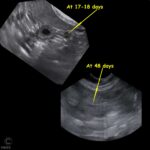Ron Hines DVM PhD
 Stages Of Labor – When Your Dog Gives Birth
Stages Of Labor – When Your Dog Gives Birth

Pregnancy in dogs last from 57-65 days. The average is 63 days, about nine weeks.
Considerably less than half of canine pregnancies are planned events. The usual explanation I am given is that they had planned to get their teenage dog spayed. They really did, I know that. But most are young couples, beginning their careers, caring for small children, on a tight budgets, living in rental houses with bills and rent to pay on their minds. They meant to – but they didn’t. But when you are fortunate enough to to plan ahead for puppies, here are some of the things that I suggest:
If this is a planned pregnancy, be sure that your future mother dog is almost 2 years old. Many dogs are accidentally bred on their first heat, when they are not much more than puppies themselves. I advise my clients who want puppies, to breed their dogs on their third heat period. By that time, the length of your dog’s estrus cycle will have been established, and you can plan ahead for the event. Most dogs cycle every 5-8 months. So, they will be about 20-24 month old when they are first bred. Toy and small breeds come into their heat more frequently – as often as every 5 month. Giant breeds, such as St. Bernards, are more likely to have a heat cycle every year or so.
How Early Can I Be Certain That My Dog Is Pregnant?
About a month after mating, you might notice that your dog’s nipples are more prominent than they were before. At about the same time, it is common for a pregnant dogs to have a light vaginal discharge. Your dog will probably not gain weight until about the 35th day, at which time you will notice that her abdomen is beginning to enlarge. How much, and when also depends on how many puppies she is carrying.
An abdominal ultrasound examination, performed by your veterinarian, is currently the best way to confirm that your dog is pregnant. With that technique, the first evidences of pregnancy are visible as early as three weeks. Look at the ultrasound diagram directly above. By 28 days they should be much more obvious. Since the expanding oviducts (dogs have tubal pregnancies) are entwined with its intestines, your veterinarian will not be able to tell you with certainty how many puppies are present.
From about the 20-22 day of pregnancy, your veterinarian can usually manually detect puppy fetuses in your dog. As time goes by and their images become more distinct on ultrasound, their beating hearts can be seen as well. The heart rate of puppy’s in the womb is fast – ~220 beats per minute. (read here & here)
Your veterinarian can also confirm that your dog is pregnant using a canine pregnancy test. That test detects the increased presence of a hormone, relaxin. That blood test can be run as early as 22-25 days. Some female dogs behave as if they were pregnant when they are not. That is called pseudopregnancy. Relaxin test results can tell the difference between pregnancy and pseudopregnancy.
From about the 30th day on, your veterinarian will be able to guess the number of puppies that are present by palpating your dog’s abdomen. Accuracy depends on your dog’s temperament in allowing palpation, the degree it tenses up its abdomen, how fat your dog it is and its body size. Late in pregnancy, counting the puppies safely becomes difficult again. Huge dogs are more difficult for me to palpate. If your dog is in early pregnancy, your veterinarian should be able to detect its swollen uterine horns which is the first sign. Be sure your dog has not eaten recently and has had a chance to defecate. Soon after, small bumps or lumps similar to pearls on a necklace can be felt. One must never squeeze those lumps! X-rays will also show the fetuses once their skeletons have begun to calcify. That is the only certain way to count the number of puppies present. I would discourage you from x-rays without a medical necessity to do so.

Planned Event
If this pregnancy is a planned event, I suggest that you take your mother-to-be in for a veterinary examination three months prior to having her bred. Besides a thorough examination, your veterinarian will verify that your dog is free of intestinal parasites and heartworms. A general blood laboratory screening panel and perhaps a blood test for brucellosis for both her and her future stud are always a good idea. (read here) The Brucella PCR test is the most accurate method. If your dog is overweight, it might be susceptible to more pregnancy complications than a trimmer dog. Toy breeds and short-nosed breeds (brachycephalic breeds) are the ones most likely to experience complications during pregnancy.
Place your dog on a diet if she needs one, six months prior to having her bred. Read about weight loss strategies here. If your female dog was ever hit by a car or suffered a pelvic injury, a pelvic exam and/or x-ray would be very desirable as well. Prior pelvic fractures can obstruct the birthing canal. If yours is a purebred dog, research the genetic diseases her breed is prone to. Genetic screening tests, such as Embark™, exist for many inherited canine genetic diseases.
If My Dog Is Pregnant, Should I Change Her Food Or Feed Her More?
No.
If you are already feeding your dog a quality dogfood, a top-of-the-line one that meets AAFCO guidelines for adult dogs and that contains abut 23% protein, 12% fat and 3.2% fiber, there is no need to change her diet. However, if this is a thin rescue dog or a nutritionally deprived dog, the protein content of the diet should be higher – at least 29% protein, 17% fat and a lower fiber content. Puppy food often fits that bill. In healthy, normal weight dogs, the amount of food consumed should be about the the same as before the pregnancy for the first two thirds of her pregnancy (approximately the first 6 weeks). Vitamin and nutritional supplements are not required. These supplements can actually unbalance the vitamin premix that the pet food manufacturers already added. Once six weeks has passed, your dog should naturally increase the amount of food she eats. She will probably eat smaller meals but more frequent meals due to the pressure the growing embryo puppies are placing on her stomach. As whelping (delivery) time approaches (~the last three weeks), she might be eating about one and one half times what she did before her pregnancy. That is quite variable because smaller dogs tend to need more calories per pound of their body weight than large dogs and her appetite is quite dependent on how many puppies she is carrying. With a large litter, three weeks after giving birth your dog might be eating up to three times her normal amount.
What Medications Are Safe To Give My Dog During Her Pregnancy?
You don’t want to stop giving your dog its heartworm control medications while it is pregnant. According to the American Heartworm Society, “All heartworm preventives are approved as safe and effective in breeding, pregnant, and lactating dogs when used according to label directions”.
Flea control is also very important in late pregnancy because your dog’s inactivity gives fleas the upper hand. However, the only flea and internal parasite control product that I know of that was ever scientifically studied in pregnant dogs is selamectin (Revolution® & perhaps generic equivalents). (read here) On most other flea prevention products, the label instructions that the company place says, “consult your veterinarian”. Well, if the pharmaceutical company that made the product is unsure if it is safe to give to pregnant dogs, why should your veterinarian know? Other products that had a “safe for pregnant dogs” note on their label when I last looked were Frontline Plus™, Fiproguard Plus™, Pet Armor Plus™, Parastar dog™, and Frontline Topspot drops™. Labels change – read the label!
Roundworms can pass from a mother dog to its puppies while the puppies are still in the womb. So many professional breeders worm their dogs with pyrantel pamoate. The FDA considers pyrantel pamoate to be safe to give to pregnant dogs. So is fenbendazole (Panacur®, Safe-Guard®), another broader spectrum wormer. (read here) Whereas pyrantel will kill only roundworms, fenbendazole will also kill hookworms. Hookworms can be transmitted though the mother’s milk to her puppies.
As far as the safety of other medications, little is known about their effects on puppy development while the infants are in the womb. For that, we can only look at drugs that are known to produce birth defects or embryo death in experimental animal and humans (=teratogenic). We know that certain antibiotics, including chloramphenicol, florfenicol, amikacin, gentamycin, tetracycline, doxycycline, nitrofurantoin, sulfonamides, trimethoprim. All NSAIDs, certain antihistamines and drugs given to control epilepsy (phenobarbital) can also be teratogenic. A ringworm medication, griseofulvin, also causes birth defects. Amoxicillin, ampicillin, amoxicillin/clavulanic acid, cephalexin, cefadroxil, clindamycin, erythromycin, and azithromycin are all considered safe. Metronidazole should not be used in early pregnancy, but can be used nearer to term. Antibiotics of unknown or potential concern include ciprofloxacin (or enrofloxacin), rifampin, or trimethoprim/sulfamethoxazole (TMS) when given early in pregnancy.
What About Vaccinations During Pregnancy?
It is always desirable that your dog’s vaccinations be up-to-date before breeding. Vaccinations can be over administered. (read here) I don’t suggest that you have vaccines given to your pregnant dog. Simple isolation from other dogs and varmints is a much safer approach. That might put you in conflict with local and state laws. I can’t offer you any solutions for that. Some states, counties and municipalities will accept a blood titer test that shows that your dog is still immune, some will not. Immune mother dogs pass on their immunity in their first milk (colostrum). That is why vaccinating pups under 8 weeks of age is of no value unless the mother dog lacked the immunity given by her prior vaccination or actual wild virus exposure.
What Are Some Problems That Might Occur During My Dog’s Pregnancy?
Over 90% of pregnant dogs will go on to deliver healthy puppies. But not every dog will. Even though you confirmed your dog’s pregnancy, sometimes pregnancies fail, embryos are reabsorbed or still births occur. That could be due to genetic incompatibilities between the mother and the stud or even a prior blood transfusion. (read here)
Eclampsia – Milk Fever
Although both can lead to seizures, eclampsia in dogs has a different cause than eclampsia in women.
In dogs, eclampsia occurs when your dog’s blood calcium level drops too low. When that occurs, it is generally close to your dog’s projected whelping date or, more likely, within the first three weeks thereafter. Toy and small breeds of dogs appear more susceptible. That late pregnancy and early postnatal period is when the puppies are rapidly laying down bone and teeth and when your dog’s need for blood calcium to add to its milk is at its highest. Eclampsia often begins with your dog appearing restless, nervous, worried and, perhaps, stiff. Your dog might whine in apprehension. If her blood calcium level drops further, she might pant and run a fever, drink excessively or twitch. Severe cases can progress to outright seizures. Very few health issues can be mistaken for eclampsia – perhaps a mammary gland infection, hypoglycemia or a uterine infection. But those are things your veterinarian can easily rule out. A positive response to intravenous calcium confirms the diagnosis of eclampsia. The treatment is the injection of sterile 10% calcium gluconate solution. If tremors are present and seizures are eminent, diazepam might be given as well.
If and how much oral calcium to supply after she recovers is controversial. Providing too much oral calcium – either during pregnancy in an attempt to prevent eclampsia or after an episode – can actually misinform your dog’s parathyroid glands as to your dog’s need for parathyroid gland-generated PTH hormone. That would further lower its blood calcium. Your veterinarians will have to make that decision.
Mastitis
Near the end of her pregnancy, your dog’s mammary glands will enlarge and begin to produce secretions. It is uncommon, but a few dogs can develop breast infections even before their puppies are born. More commonly, if mastitis develops, it will be during the first first two or three weeks after delivery. One or more mammary glands can be affected. They are hard, painful and often discolored. Mastitis develops when skin bacteria invade the mammary gland. Much less commonly, the dog has a bacterial blood infection that has localized in the gland(s). Puppy or other trauma to the nipple which restricts milk flow can also be the cause.
Pyometra
Pyometra, a uterine/tube infection, is considerably more likely to occur in older pregnant dogs. It has also been associated with mismating estrogen shots as well. When your dog’s cervix is open, drainage and a vaginal discharge are common. If its cervix is closed they are not. Increased thirst, urination and abdominal distention are common signs in closed cervix cases. Laboratory tests usually reveal an elevated white blood cell count. Some of these dogs run fevers, others have lower-than-normal body temperature. Other signs occur such as poor appetite and panting, but none are diagnostic for pyometra. Abnormal blood progesterone levels are thought to be the underlying cause. When samples of the thick fluid filling the uterine horns are sampled, the bacteria involved are almost always normal inhabitants of your dog’s digestive tract. Treatment includes drainage, ovariohysterectomy (spay) after stabilization and appropriate antibiotics. I strongly suggest you not treat these dogs medically (e.g. with misoprostol) with the aim of breeding them again in the future.
Difficult Labor, Dystocia
About 5% of dog pregnancies are thought to run into problems at birthing time. Flat-faced, narrow hipped breeds such as Pugs, French Bulldogs, Boston Terriers, Pekingese and Shih-Tzu (the brachycephalic breeds) are considerably more likely to have birthing problems than dogs whose body shapes conform more to the traditional dog/wolf silhouette.
In all breeds, the problem can be in the mother or the puppies. Perhaps a litter of one or two in which the puppy grew too large in the womb to pass through the birthing canal. More often though, the problem is a uterus and uterine horns that fail to contract forcefully enough to expel the puppies (uterine inertia). Labors lasting longer than one hour without delivery of the first puppy, in multiple births more than 1.5 hours with no second puppy, a greenish black discharge without a delivery or more than 7.5 hours in labor with still no first puppy, are all reasons for concern. How long your dog might be in labor is quite variable. The average length of labor is ~7.5 hours, but the range is 3-12 hours. An ultrasound examination is extremely helpful to your veterinarian in deciding what needs to be done. Oxytocin and calcium gluconate injections and hand and instrument assisted manipulations can be helpful if there are no blockages to your dog’s birthing canal and if the retained puppy(s) are of normal size. If no puppy arrives within 30-60 minutes after the injections, a C-section is your best option. Usually, placentas are passed within 15 minutes of the puppy’s arrival. You ought to count them before the mother eats them to be sure they equal the number of puppies. A green vaginal discharge is normal. A fever is not.
Gestational Diabetes
Only a few dogs have the potential to develop diabetes during their pregnancy. Increased thirst and urination occurs, similarly to what sometimes occurs in eclampsia. Gestational diabetic dogs are more likely to have urine accidents in the house. An elevated fasting blood glucose level is diagnostic.
As I mentioned, over 90% of pregnancies deliver healthy puppies. But if you want to know in detail how veterinarians treat those that do develop problems read here.
You are on the Vetspace animal health website
Visiting the products that you see displayed on this website help pay the cost of keeping these articles on the Internet.



